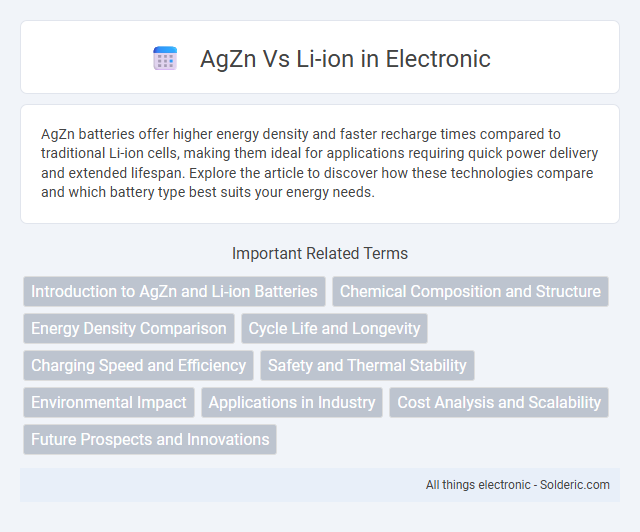AgZn batteries offer higher energy density and faster recharge times compared to traditional Li-ion cells, making them ideal for applications requiring quick power delivery and extended lifespan. Explore the article to discover how these technologies compare and which battery type best suits your energy needs.
Comparison Table
| Feature | AgZn Battery | Li-ion Battery |
|---|---|---|
| Energy Density | High (up to 150 Wh/kg) | Very High (150-250 Wh/kg) |
| Voltage | 1.5-1.8 V per cell | 3.6-3.7 V per cell |
| Cycle Life | Moderate (100-200 cycles) | High (500-2000+ cycles) |
| Cost | Higher due to silver content | Lower, widely manufactured |
| Safety | Stable, less prone to thermal runaway | Requires protection circuits due to fire risk |
| Applications | Military, aerospace, specialized devices | Consumer electronics, EVs, energy storage |
| Environmental Impact | Silver is recyclable but costly | Raises concerns over lithium mining |
Introduction to AgZn and Li-ion Batteries
AgZn batteries utilize silver oxide and zinc as electrode materials, offering high energy density and excellent discharge characteristics compared to traditional chemistries. Li-ion batteries, based on lithium-ion intercalation in various cathode and anode materials, dominate portable electronics due to their high capacity, long cycle life, and lightweight design. Both battery types serve different applications, with AgZn favored in high-performance military and aerospace sectors, while Li-ion powers widespread consumer electronics and electric vehicles.
Chemical Composition and Structure
AgZn batteries consist of a silver oxide cathode and a zinc anode, offering a unique electrochemical reaction different from lithium-ion batteries, which use lithium metal oxides or phosphates as cathodes and graphite as anodes. The AgZn structure enables higher energy density and improved safety due to its stable chemistry and reduced risk of thermal runaway compared to the layered crystal structure of lithium-ion cells. Understanding these differences can help you choose the optimal battery technology for specific applications requiring reliable performance and safety.
Energy Density Comparison
Silver-Zinc (AgZn) batteries offer an energy density of approximately 130-150 Wh/kg, which is generally lower than Lithium-ion (Li-ion) batteries that range from 150-250 Wh/kg depending on the chemistry. Li-ion batteries dominate in high energy density applications, making them ideal for electric vehicles and portable electronics requiring longer runtimes. While AgZn batteries have advantages in safety and environmental impact, their lower energy density limits their use in energy-intensive scenarios compared to Li-ion technology.
Cycle Life and Longevity
AgZn batteries typically offer a cycle life of around 500 to 1000 charge-discharge cycles, with stability suitable for applications requiring moderate longevity. Li-ion batteries, by contrast, commonly achieve 1000 to 2000 cycles, benefiting from advanced chemistry that supports longer-term energy retention and durability. Your choice depends on prioritizing AgZn's high energy density and rapid discharge capabilities versus the extended cycle life and proven longevity of Li-ion technology.
Charging Speed and Efficiency
AgZn batteries offer faster charging speeds compared to traditional Li-ion cells due to their higher ionic conductivity and lower internal resistance. This efficiency in charge acceptance allows AgZn batteries to reach full charge more quickly, reducing downtime significantly in applications requiring rapid energy replenishment. Your devices could benefit from enhanced operational time and quicker turnaround when powered by AgZn technology over conventional lithium-ion batteries.
Safety and Thermal Stability
AgZn batteries exhibit superior safety and thermal stability compared to Li-ion batteries due to their inherently non-flammable aqueous electrolyte, reducing the risk of thermal runaway and combustion. Li-ion batteries, while offering high energy density, are prone to overheating and potential fire hazards under extreme conditions because of their organic electrolytes. Enhanced safety protocols in AgZn cells make them ideal for applications requiring stringent thermal management and reliable performance under high-temperature environments.
Environmental Impact
AgZn batteries feature significantly lower environmental impact compared to Li-ion batteries due to their use of less toxic materials and greater recyclability potential. Lithium-ion production involves extensive mining of lithium and cobalt, contributing to habitat destruction and pollution, whereas silver and zinc are more abundant and easier to recycle. Your choice of AgZn batteries supports sustainability by reducing hazardous waste and minimizing ecological footprint during disposal.
Applications in Industry
AgZn batteries are widely utilized in military and aerospace industries due to their high energy density, lightweight nature, and excellent performance under extreme conditions. Li-ion batteries dominate consumer electronics, electric vehicles, and renewable energy storage because of their superior rechargeability, longer lifecycle, and efficiency. Your choice between AgZn and Li-ion technology depends on the specific energy requirements and environmental constraints of the intended industrial application.
Cost Analysis and Scalability
AgZn batteries have a higher initial cost compared to Li-ion due to silver's expense but offer longer cycle life that can reduce total cost of ownership in large-scale applications. Li-ion technology benefits from extensive manufacturing infrastructure, significantly lowering production costs and enabling rapid scalability for mass markets. Your choice depends on balancing upfront investment with long-term durability and the intended scale of deployment.
Future Prospects and Innovations
Silver-zinc (AgZn) batteries offer significant potential for high-energy-density and rapid recharge capabilities, positioning them well for future aerospace and military applications where weight and performance are critical. Innovations such as solid-state electrolytes and nanostructured electrodes are enhancing AgZn cycle life and safety, narrowing the gap with lithium-ion (Li-ion) technology. With ongoing research improving cost-effectiveness and stability, AgZn batteries could complement Li-ion cells in specialized markets requiring fast, reliable power storage and extended operational lifespans.
AgZn vs Li-ion Infographic

 solderic.com
solderic.com